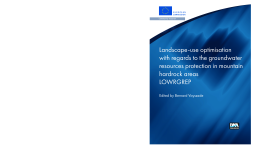
BOOK
Landscape-use optimisation with regards to the groundwater resources protection in mountain hardrock areas
B. Vayssade | S. Bender | Z. Boukalova | A. L. Courbis | J. F. Didon-Lescot | Z. Hrkal | A. Perez Garcia | C. Martin | P. Martinez Alfaro | P. Martinez-Santos | E. Montero | J. A. Sanchez-Navarro | S. Sauvagnargues-Lesage | F. Villarroya | S. Wohnlich | J. G. Yélamos
(2008)
Additional Information
Book Details
Abstract
This EC report is only available online.
This report assesses the degree of interference of human activities with the hydrosphere in mountain-zones, all located in hard-rock areas of different countries in the European Union. Each of the test regions has a specific degree of protection: from regions with very few inhabitants and very low human impact, to regions submitted to a strong anthropogenic impact. The investigations focused on the changes in water quality and on the simulation of various alternatives leading to optimum landscape-use from the point of view of water-management. The project’s own Geographic Information System was used to fulfil the following objective: present all the obtained knowledge and analyse all the data in user-friendly form (maps of water vulnerability) and make this knowledge available for potential users with, for instance, the creation and use of a web site. A simulation tool has been developed which facilitates the assessment of the impact of landscape-use on the water budget of the catchment.
In all the areas investigated chloride is present, only in winter and very close to roads. Another result of this work is the decreasing impact on water of sulphur and sulphuric compounds in Germany and in the Czech Republic, while the nitrogen impact is increasing. Recommendations concerning the landscape-use are presented for all the regions in particular for good practices in agriculture.
Table of Contents
| Section Title | Page | Action | Price |
|---|---|---|---|
| Contents | 6 | ||
| Authors | 8 | ||
| Part 1: Publishable Final Report Non Confidential | 12 | ||
| 1.1 Executive publishable summary: | 12 | ||
| 1.2 Publishable synthesis report: | 13 | ||
| Part 2: Detailed Final Report | 16 | ||
| 2.1 Objectives and strategic aspects: | 16 | ||
| 2.2 Scientific and technical description of the results: | 17 | ||
| 2.2.1. WP1 Identification of the Areas: | 17 | ||
| Selection of small experimental catchments and demarcation of areas for regional studies: | 17 | ||
| Review of current pollution problems in partner countries; identification of conflicting policies between the groundwater protection and other sectors: | 18 | ||
| Set up of all collected data and their transfer into computer form, elaboration and set up of a uniform method for sampling and data processing | 18 | ||
| Assessment of local and regional land use policy in partner countries: | 18 | ||
| Complete survey of natural and socio-economic conditions in all the studied and compared regions: | 19 | ||
| 2.2.2. WP 2 Assessment of the local landscape use impact on hydrosphere in the mountain regions: | 19 | ||
| Assessment of hydrochemical balance in the network of the experimental small catchments: | 19 | ||
| Detailed analysis of run off changes in hard-rock regions: | 19 | ||
| 2.2.3. WP 3 Assessment of the regional human activity influence on the groundwater quality in the mountain regions: | 20 | ||
| Regional risk of acidification: | 21 | ||
| Direct and local pollutions: | 21 | ||
| 2.2.4 WP 4 Perspective of the regional groundwater exploitation in the mountain regions from the quantitative standpoint: | 23 | ||
| Assessment of groundwater exploitable resources (“safe yield”) in mountainous hardrock areas | 23 | ||
| Analysis of the factors which influence the groundwater resources: | 24 | ||
| 2.2.5 WP 5 Hydrogeological Decision Support System in Mountain Areas (HYDRODESUSMA) | 25 | ||
| Specification of a generic model for simulation: | 25 | ||
| 2.2.6 WP 6 Final results: | 34 | ||
| Testing of Hydrodesusma : | 34 | ||
| Dissemination of results: | 34 | ||
| Assessment of results and conclusions: | 36 | ||
| ACKNOWLEDGEMENTS: | 41 | ||
| REFERENCES: | 41 | ||
| Technical references: | 41 | ||
| Legislative references : | 41 |
